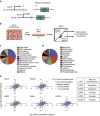PARP3 is a promoter of chromosomal rearrangements and limits G4 DNA
- PMID: 28447610
- PMCID: PMC5414184
- DOI: 10.1038/ncomms15110
PARP3 is a promoter of chromosomal rearrangements and limits G4 DNA
Erratum in
-
Corrigendum: PARP3 is a promoter of chromosomal rearrangements and limits G4 DNA.Nat Commun. 2017 Jun 13;8:15918. doi: 10.1038/ncomms15918. Nat Commun. 2017. PMID: 28607496 Free PMC article.
Abstract
Chromosomal rearrangements are essential events in the pathogenesis of both malignant and nonmalignant disorders, yet the factors affecting their formation are incompletely understood. Here we develop a zinc-finger nuclease translocation reporter and screen for factors that modulate rearrangements in human cells. We identify UBC9 and RAD50 as suppressors and 53BP1, DDB1 and poly(ADP)ribose polymerase 3 (PARP3) as promoters of chromosomal rearrangements across human cell types. We focus on PARP3 as it is dispensable for murine viability and has druggable catalytic activity. We find that PARP3 regulates G quadruplex (G4) DNA in response to DNA damage, which suppresses repair by nonhomologous end-joining and homologous recombination. Chemical stabilization of G4 DNA in PARP3-/- cells leads to widespread DNA double-strand breaks and synthetic lethality. We propose a model in which PARP3 suppresses G4 DNA and facilitates DNA repair by multiple pathways.
Conflict of interest statement
The authors declare no competing financial interests.
Figures








Similar articles
-
Parp3 promotes long-range end joining in murine cells.Proc Natl Acad Sci U S A. 2018 Oct 2;115(40):10076-10081. doi: 10.1073/pnas.1801591115. Epub 2018 Sep 13. Proc Natl Acad Sci U S A. 2018. PMID: 30213852 Free PMC article.
-
PARP3 affects the relative contribution of homologous recombination and nonhomologous end-joining pathways.Nucleic Acids Res. 2014 May;42(9):5616-32. doi: 10.1093/nar/gku174. Epub 2014 Mar 5. Nucleic Acids Res. 2014. PMID: 24598253 Free PMC article.
-
TRABID overexpression enables synthetic lethality to PARP inhibitor via prolonging 53BP1 retention at double-strand breaks.Nat Commun. 2023 Mar 31;14(1):1810. doi: 10.1038/s41467-023-37499-5. Nat Commun. 2023. PMID: 37002234 Free PMC article.
-
Differential requirement for H2AX and 53BP1 in organismal development and genome maintenance in the absence of poly(ADP)ribosyl polymerase 1.Mol Cell Biol. 2010 May;30(10):2341-52. doi: 10.1128/MCB.00091-10. Epub 2010 Mar 15. Mol Cell Biol. 2010. PMID: 20231360 Free PMC article.
-
Regulation of DNA repair in the absence of classical non-homologous end joining.DNA Repair (Amst). 2018 Aug;68:34-40. doi: 10.1016/j.dnarep.2018.06.001. Epub 2018 Jun 12. DNA Repair (Amst). 2018. PMID: 29929045
Cited by
-
Mechanisms driving chromosomal translocations: lost in time and space.Oncogene. 2021 Jun;40(25):4263-4270. doi: 10.1038/s41388-021-01856-9. Epub 2021 Jun 8. Oncogene. 2021. PMID: 34103687 Free PMC article. Review.
-
Multiple Roles for Mono- and Poly(ADP-Ribose) in Regulating Stress Responses.Trends Genet. 2019 Feb;35(2):159-172. doi: 10.1016/j.tig.2018.12.002. Epub 2018 Dec 27. Trends Genet. 2019. PMID: 30595401 Free PMC article. Review.
-
DNA folds threaten genetic stability and can be leveraged for chemotherapy.RSC Chem Biol. 2020 Sep 30;2(1):47-76. doi: 10.1039/d0cb00151a. eCollection 2021 Feb 1. RSC Chem Biol. 2020. PMID: 35340894 Free PMC article. Review.
-
Parp3 promotes long-range end joining in murine cells.Proc Natl Acad Sci U S A. 2018 Oct 2;115(40):10076-10081. doi: 10.1073/pnas.1801591115. Epub 2018 Sep 13. Proc Natl Acad Sci U S A. 2018. PMID: 30213852 Free PMC article.
-
Treatment of Sulfur Mustard Corneal Injury by Augmenting the DNA Damage Response (DDR): A Novel Approach.J Pharmacol Exp Ther. 2024 Jan 17;388(2):526-535. doi: 10.1124/jpet.123.001686. J Pharmacol Exp Ther. 2024. PMID: 37977813 Free PMC article.
References
-
- Piomboni P., Stendardi A. & Gambera L. Chromosomal aberrations and aneuploidies of spermatozoa. Adv. Exp. Med. Biol. 791, 27–52 (2014). - PubMed
-
- Bochtler T., Frohling S. & Kramer A. Role of chromosomal aberrations in clonal diversity and progression of acute myeloid leukemia. Leukemia 29, 1243–1252 (2015). - PubMed
Publication types
MeSH terms
Substances
Grants and funding
LinkOut - more resources
Full Text Sources
Other Literature Sources
Molecular Biology Databases
Research Materials
Miscellaneous

